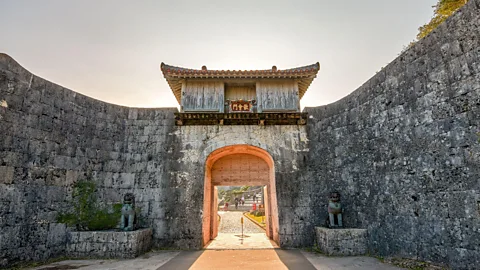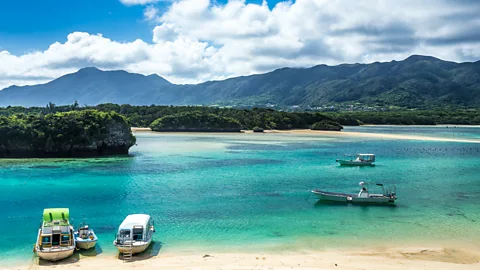The women saving Japan's vanishing cuisine
 Getty Images
Getty ImagesFor 450 years, the little-known Ryukyu Kingdom thrived in what is now Japan. Now, after nearly vanishing, its unique fusion cuisine is being revived.
"You can learn a lot about a person by looking at their tongue," Yukie Miyaguni tells me in the kitchen-classroom of her second-storey apartment in Uruma, a city on the Japanese island of Okinawa. I've taken a few cooking classes over the years, but this is the first time anyone's ever asked to examine my tongue.
With my mouth agape, Miyaguni – a Traditional Chinese Medicine (TCM) practitioner and Ryukyuan chef – gives my tongue a long look before drawing its likeness on a whiteboard and offering a prescription: "More cacao at night, honey in the morning and more butter," she concludes, noting it will help improve my blood circulation and dry skin.
I didn't come to Okinawa for a diagnosis per se, but in many ways, it was my taste buds that led me to Miyaguni's kitchen. I had been hoping to learn more about the island's elusive and indigenous Ryukyuan cuisine, which can be traced back to the 12th Century when the Ryukyu Islands began trading with other East Asian states.
 Getty Images
Getty ImagesThe Ryukyu Islands stretch more than 1,100km, from the southern tip of Kyushu to north-eastern Taiwan. From 1429-1879, the archipelago flourished as a semi-autonomous state known as the Ryukyu Kingdom and was an important cross-section of maritime trade during its 450-year history. Over time, the islands developed a distinctive cultural and culinary identity that blended endemic ingredients like bitter melon, shikuwasa (a lime-like citrus fruit), beni-imo (purple sweet potatoes) and mozuku seaweed with non-native cooking techniques and ingredients. Siamese (modern-day Thai) traders brought indica rice; the Chinese introduced a variety of herbs, teas and pork; and Korean merchants taught residents how to pickle and ferment seafood and vegetables.
World's Table
BBC.com's World's Table "smashes the kitchen ceiling" by changing the way the world thinks about food, through the past, present and future.
As Miyaguni explained, when the Kingdom's royal family welcomed visiting envoys and magistrates, they did so with a refined style of cooking and customs called "court cuisine" (Ukwanshin Ryori), in which portions of hana-ika (sliced squid), minudaru (steamed pork in seasame sauce), gunbomachi (burdock root wrapped in pork) and more were presented in a Ryukyuan lacquerware called a tundabun.
When Japan annexed and renamed the island chain Okinawa in 1879, court cuisine spread from the upper echelons of Ryukyuan society to the countryside. Everyday households continued to down home-cooked recipes from the islands' more relaxed "folk cuisine" as well. But when US forces occupied Okinawa for several decades after World War Two, a mixture of American fast food influence, a rapid assimilation to Japanese culture, food shortages and economic hardships led to the near disappearance of the islands' ancient fusion food culture.
Now, thanks to a growing contingent of women like Miyaguni, a resurgence of Ryukyuan cuisine is quietly underway.
"This was the food of our ancestors," Miyaguni says, slicing into a pimply green bitter gourd called goya and tossing it into a small mixing bowl along with tofu, eggs and pork to make a traditional style of stir fry called champaru. Meaning "to mix together", champaru dishes are often considered the spirit of Okinawa because they reflect the islands' diverse influences. "By cooking this way," Miyaguni continued, "we honour their [memories] and keep this ancient culture alive."
 Michelle Gross
Michelle GrossAs with traditional Japanese cuisine on the mainland, Ryukyuan food is rooted in locally sourced and seasonal ingredients. Dishes and ingredients like goya champaru, jimami (peanut) tofu, slow-boiled agu (pork) and umibudo (sea grapes) served in tundabun or Okinawan pottery called yachimun are integral to keeping the traditions of Ryukyuan court cuisine and folk cuisine alive.
"Ryukyuan cuisine is not colourful, so using these plates and lacquerware helped make the food look more vivid," Miyaguni explained, pointing to the fire engine-red tundabuncontaining each dish on the table.
After we finished kneading the dough for chinsuko (a traditional Okinawan shortbread made of lard, flour and sugar) and placed it in the oven, we sat down to enjoy the fruits of our labour. As I savoured delicate bites of buttery soft peanut tofu, slices of black sesame-coated pork loin and mung bean rice balls wrapped in banana leaves, Miyaguni explained the health benefits of Ryukyuan food. She said ingredients like bitter melon and purple sweet potatoes are high in antioxidants and help lower blood sugar and aid digestion, while awamori, a locally distilled spirit, can aid in gut health.
Miyaguni's interest in preserving Ryukyuan food culture is rooted in the Chinese philosophy of food as medicine. After retiring as a nutritionist at a hospital in Okinawa in 2008, Miyaguni encountered TCM and began to learn about its "deep connection" to Ryukyuan cuisine. For the last 10 years, Miyaguni has been teaching locals and visitors about the health components of Ryukyuan cuisine from her home. In 2018, she was selected as a representative of Ryukyuan cuisine by the Okinawa Prefectural Governor.
 Alamy
Alamy"Until now, Okinawa has been the pride of the world as the island of longevity. However, now the health of the people is deteriorating," Miyaguni said.
Miyaguni explained that even after the islands were annexed, Ryukyuan folk cuisine was still governed by the Chinese philosophy of ishoku dogen, which emphasises the importance of using high-quality, seasonally available ingredients. Homemade tofu, mugwort soup, purple potato and bitter melon remained staples of folk cuisine, along with the Confucian belief of using all parts of the pig. "Everything but the oink," Miyaguni said.
Today, Miyaguni still keeps a book in her kitchen called Gozen Honzō (Edible Plants of Ryukyu), which was written by a chief physician to the king of the Ryukyuan Kingdom. "Gozen Honzō… explains the types of and used of edible plants, animals and many other foods and a number of sections describe methods of preparing them," Miyaguni said.
"We've lost the Ryukyuan language because it isn't taught, but understanding how our ancestors cooked, and teaching these traditions is how we will continue to protect the Ryukyuan culture for future generations," she added.
 Michelle Gross
Michelle GrossWhile Miyaguni's interest in preserving Ryukyuan cuisine stems from her medicinal background, Kazumi Kayo, a Ryukyuan cooking instructor and food culture ambassador for the Okinawa Prefecture, says her interest in reviving these culinary traditions goes back to her mother.
"When I was young, I was not interested in Ryukyuan cuisine," Kayo said. "However, the memory of the taste that my mother made for me since I was a child came back to me, and I wanted to maintain a cooking method that brought out the taste of these simple ingredients, so I specialised in cooking, obtained a qualification and started a cooking class."
But Kayo is aware that the region's famous longevity – which many believe is inextricably linked to its diet – is increasingly in peril.
"For a long time, Okinawa prefecture has maintained the world's longest life expectancy, but with the Westernisation of food, that ranking has dropped, and now the number of people suffering from lifestyle-related diseases is increasing, which is a problem for the prefecture," Kayo said.
In 2016, Okinawa's prefectural government developed a programme called Ryukyuan Cuisine Masters to help preserve Ryukyuan food while also addressing rising health concerns.
 Michelle Gross
Michelle Gross"About five years ago, we strengthened training for chefs in the food and beverage industry and nutrition associations, provided them with qualifications and started activities to on and popularise Ryukyuan cuisine, including traditional cooking methods," Kayo added. "I think the residents of the prefecture will realise the goodness of Ryukyuan cuisine again."
Now in her 18th year as a Ryukyuan cooking instructor, Kayo runs the Yonner Food Cooking Studio, whose classes start by taking locals and visitors to Makishi Public Market in downtown Naha. "Yonnerfood' means 'slow food' in Okinawan dialect, and by having a leisurely chat while shopping and taking a cooking class, I hope to help people learn about Okinawa's food culture and develop a love for Okinawa," Kayo said.
More like this:
• Japan's spectacular bike ride through six remote islands
In 2019, in an effort to further prevent the decline of Ryukyuan cuisine, the non-profit Ryukyu Cuisine Preservation Association was established to safeguard and promote the culinary heritage of the Ryukyu Kingdom. The same year, "The Unbroken Legacy of the Ryukyu Kingdom" and its unique food culture was ed as a national heritage of Japan.
In addition to educational cooking classes like Miyaguni's and Kayo's, a handful of Ryukyuan restaurants and food tours have also cropped up across the islands.
Local tour guide Junko Yokoo's Blue Zone Okinawa Home Cooking Tour takes guests to the home of Hiromi Nerome, another certified Ryukyuan cuisine specialist and chef whose own cooking class is based out of her home in the seaside village of Nakijin.
 Getty Images
Getty Images"I started offering this tour in 2022 in response to tourists' interest in Okinawa's 'longevity' cuisine," Yokoo tells me. "Locally grown vegetables like bitter melon and purple sweet potato are quite different from mainland Japan, so people are curious to taste them and learn about what makes Okinawan food so healthy."
In 2024, Suitenrou opened in downtown Naha and offers a mix of Ryukyuan folk and court cuisine along with traditional music and dancing. For a more formal court cuisine-inspired affair, Kuninda also in downtown Naha serves classic dishes like stewed pork cubes in white miso and sea grapes topped with freshly grated wasabi.
But if you ask Miyaguni or Kayo, they will tell you that the key to preserving Ryukyuan food culture starts in the kitchen and is best learned through hands-on experience.
"I think that if we can spread the word and attract attention outside the prefecture and abroad, the people of the prefecture will once again realise the goodness of Ryukyuan cuisine," Kayo said. "If Ryukyuan cuisine disappears, we will lose the identity of Okinawa, so we must preserve it."
--
